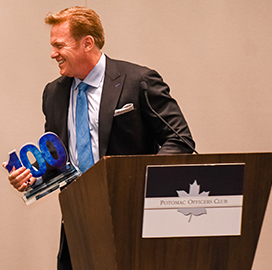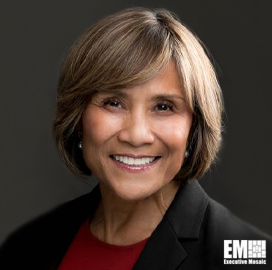Potomac Officers Club hosted its Supply Chain Resilience and COVID-19 Virtual Event on June 11th, featuring keynote speaker Rear Adm. John Polowczyk, supply chain task force lead for the Federal Emergency Management Agency (FEMA), and an expert panel with federal, academic and industry thought leaders.
In case you missed the event, click here to replay POC’s Supply Chain Resilience and COVID-19 Virtual Event.
Brian Fitzpatrick, president and CEO of LMI, opened the event, providing an overview of how LMI has supported its customers during the COVID-19 pandemic and the immense supply chain challenges that the industry and federal sectors have had to manage.
“For much of the country, the past few months have opened a lot of eyes to the importance of supply chain logistics. I have to believe there is a greater appreciation for how medical equipment are produced, and how to maintain those operations even when the most unlikely events occur,” Fitzpatrick stated.
Stuart Jones, director of Supply Chain Management with LMI, introduced Polowczyk. Jones provided a brief overview of Polowczyk qualifications and experience, including his time with the U.S. Military and his educational background.
“John was recently selected by the President to lead FEMA’s multi-agency supply chain task force, where he’s focusing on government and industry collaboration to maximize the availability of the critical protective and lifesaving equipment for a whole-of-nation response,” Jones said.
Polowczyk provided an overview of FEMA’s supply chain task force to start. He noted how he entered the role without resources, but with a significant demand as well as a great competition across all sectors for supplies. Polowczyk added that to solve the crisis, he implemented four lines of effort: acceleration, preservation, allocation and expansion.
Acceleration focused on expediting production and the gathering of products, and then improving the transportation time of the necessary materials. He noted that FEMA advanced its research of new sources to accelerate and collaborated with the public and private sectors to expedite the process.
In case you missed the event, click here to replay POC’s Supply Chain Resilience and COVID-19 Virtual Event.
Under preservation, Polowczyk worked with the Center for Disease Control (CDC) to discover new ways to make personal protective equipment (PPE). He also implemented decontamination efforts and analyzed “what the critical workers could do today to make supplies last longer.”
Polowczyk’s allocation, or “data effort,” took six business systems from across the healthcare supply chain and compiled them in a FEMA data lake, to utilize a data visualization tool. The analysis enabled the agency to understand the businesses and see where the companies will deliver materials to the point of care. The tool enabled FEMA to have a comprehensive view of the supply chain.
The agency has also tracked drugs to allocate and understand the medicinal needs of suppliers. “Disease data from CDC allowed us to correlate epidemiology with supply and demand to conduct burn rate analysis to aggregate demand and understand supply chain needs,” Polowczyk said.
Through expansion, FEMA will discover where to expand U.S. production. The Coronavirus Aid, Relief, and Economic Security (CARES) Act has enabled FEMA to use those funds to make additional investments in ventilators, N95 production, swabs for testing and more. Title 7 has also allowed the government to work with industry without antitrust agreements, which will be vital for production allocation decisions across the industry.
“There was no lack of ability to coordinate across the government in this effort. Moving forward, we’re working with HHS to bring a different strategic national stockpile forward, more range in depth and more visibility. What do we really need by resilience and what dependency should we have on foreign sources? Who is in charge of these responsibilities and to what extent? These are questions we have to ask as we move forward,” concluded Polowczyk.
In case you missed the event, click here to replay POC’s Supply Chain Resilience and COVID-19 Virtual Event.
Following Polowczyk’s address, Jones moderated the expert panel, including VADM Raquel Bono, director of the COVID-19 Health System Response Management for Washington State and a three-time Wash100 Award recipient, Dave Kless, executive director of Operations with Defense Logistics Agency (DLA) and Jim Rice, deputy director of Center for Transportation and Logistics at MIT.
“I think we see across the board an interdependence between other countries for certain supplies, but there’s a balance between speed and cost that you have to create within the supply chain,” Kless said.
Within the medical supply chain, DLA works to deliver the best products to its customers. Kless noted that COVID-19 broke the traditional model because there was a global demand for PPE and limited supplies. In those instances, developing an “enduring domestic industrial base” is critical, he said.
VADM Bono stated that every agency and business must be able to analyze its supply as well as the requirements. “With any supply chain, the important thing is to define your requirements and understand how well you define your requirements.”
She also noted that the challenge with the COVID-19 supply chain crisis is that nearly every sector globally was searching for the same PPE supplies.
“If I were to evaluate the supply chain then, I wouldn’t have necessarily looked at it in terms of resilience, I would have looked at it in terms of market responsiveness. Additionally, you have to look at the responsiveness of those supply chain vendors and getting the ‘just in time’ inventory to medical.”
Rice discussed how supply chains are measured in degrees. Many companies can deal with some distribution at some points in time, but COVID-19 or other natural disasters require more than just a few weeks of problems to fix.
“To be resilient you really have to make efforts in advance. How you perform after a disruption is really a measure of what you have done before the disruption,” Rice stated.
Business continuity planning and redundancy within companies’ supply chain management is very limited. Medical supply chains have been made very efficient, but it has taken a lot out of responsiveness, so finding a degree between responsiveness and effectiveness is what companies should begin to investigate in the coming months.
In case you missed the event, click here to replay POC’s Supply Chain Resilience and COVID-19 Virtual Event.


Mark your calendars for Potomac Officers Club’s CMMC Virtual Forum 2020 for June 24th. Click here to register for the event.
Katie Arrington, chief information security officer at the Office of the Assistant Secretary of Defense for Acquisition and a 2020 Wash100 Award recipient, will serve as a keynote speaker at the CMMC Forum 2020.
She will address the CMMC’s timeline, how the certification process could change and will provide a memorandum of understanding with a newly established CMMC accrediting body.
A full expert panel will include Ty Schieber, senior director of executive education and CMMC-AB chairman of the University of Virginia and Richard Naylor of the Defense Counterintelligence and Security Agency (DCSA) among other members of the federal sector and industry.
Register here to join Potomac Officers Club for its CMMC Virtual Forum 2020 on June 24th to learn about the impact DoD’s CMMC will have on cybersecurity practices, supply chain security and other aspects of the federal market.








